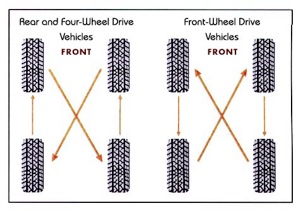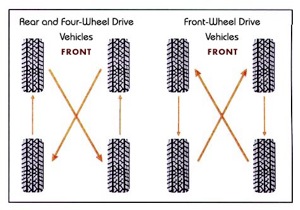As a car owner, you know the importance of maintaining your vehicle’s health. Regular oil changes, brake inspections, and tire rotations are all part of the routine maintenance that keeps your car running smoothly for years to come. But when it comes to tire rotation, many people wonder if it’s necessary for all types of cars, including those that are all-wheel drive (AWD).
The short answer is yes, AWD cars do need tire rotation. In fact, it’s just as important for AWD vehicles as it is for front-wheel or rear-wheel drive cars. But why is tire rotation so crucial, and how often should you do it? Let’s take a closer look at the importance of tire rotation for AWD cars and what you need to know to keep your vehicle in top shape.
Yes, AWD cars need tire rotation just like any other car. In fact, it is even more important for AWD cars because they distribute power to all four wheels, which can cause uneven tire wear. Regular tire rotation helps to ensure that the tires wear evenly, which can extend their lifespan and improve the car’s handling and performance. It is recommended to rotate the tires every 5,000 to 8,000 miles, or as specified in the owner’s manual.

Do AWD Cars Need Tire Rotation?
If you own an all-wheel-drive (AWD) car, you may be wondering if it needs tire rotation. Tire rotation is a common maintenance practice that involves moving the tires to different positions on the car to ensure even wear. It’s essential for all cars, including AWD cars, to have their tires rotated regularly.
What is an AWD Car?
An AWD car is a vehicle that sends power to all four wheels simultaneously. This type of drivetrain offers improved traction and handling, especially in slippery conditions. AWD cars are typically more expensive than their two-wheel-drive counterparts, but they offer better performance and safety.
Why Do AWD Cars Need Tire Rotation?
AWD cars need tire rotation for the same reasons that other cars do: to promote even wear and extend the life of the tires. However, AWD cars are more prone to uneven tire wear than other cars because of their drivetrain. Since power is sent to all four wheels, the tires experience different levels of stress and wear.
For example, the front tires of an AWD car may wear faster than the rear tires because they’re responsible for steering and braking. Similarly, the tires on one side of the car may wear faster than the other side because of the camber angle.
When Should You Rotate the Tires on an AWD Car?
The frequency of tire rotation depends on several factors, such as the type of tires, the driving conditions, and the vehicle’s alignment. However, as a general rule, you should rotate your AWD car’s tires every 5,000 to 7,000 miles.
If you notice uneven wear on your tires, such as cupping or feathering, you should have them inspected and rotated immediately. Additionally, if you replace one or two tires on your AWD car, you should rotate all four tires to ensure even wear and prevent drivetrain damage.
How is Tire Rotation Done on an AWD Car?
Tire rotation on an AWD car is similar to tire rotation on other cars, but there are some additional considerations. AWD cars require a specific tire rotation pattern to ensure even wear and prevent drivetrain damage.
Most AWD car manufacturers recommend a cross-rotation pattern, which involves moving the front tires to the opposite rear position and the rear tires to the opposite front position. This pattern ensures that the tires wear evenly and that the drivetrain isn’t damaged.
The Benefits of Tire Rotation for AWD Cars
Regular tire rotation offers several benefits for AWD cars, including:
- Extended tire life
- Better fuel economy
- Improved handling and traction
- Prevention of drivetrain damage
Tire Rotation vs. Wheel Alignment
Tire rotation and wheel alignment are two different maintenance practices that are often confused. While tire rotation involves moving the tires to different positions on the car, wheel alignment involves adjusting the angles of the wheels to ensure they’re perpendicular to the ground and parallel to each other.
Both tire rotation and wheel alignment are essential for maximizing your AWD car’s performance and safety. However, they serve different purposes and should be done at different intervals.
The Bottom Line
If you own an AWD car, it’s essential to have your tires rotated regularly to ensure even wear and extend their life. AWD cars are more prone to uneven tire wear than other cars, so tire rotation is especially important. Be sure to follow the manufacturer’s recommendations for tire rotation frequency and pattern to prevent drivetrain damage and maximize performance.
Key Takeaways: Do AWD Cars Need Tire Rotation?
- Tire rotation is essential for any car, regardless of whether it’s AWD or not.
- AWD cars tend to have more wear and tear on their tires due to their increased traction and power distribution.
- Regular tire rotation can extend the life of your tires and improve the overall performance of your vehicle.
- Tire rotation should be done every 5,000 to 7,500 miles to ensure even wear and tear on all tires.
- Skipping tire rotation can result in uneven wear on your tires, decreased fuel efficiency, and increased risk of blowouts.
- If you’re unsure about whether your AWD car needs tire rotation, consult with your mechanic or refer to your vehicle’s owner’s manual for recommended maintenance.
In conclusion, tire rotation is an important aspect of vehicle maintenance that should not be overlooked, especially for AWD cars. By regularly rotating your tires, you can ensure optimal performance, increased safety, and longer-lasting tires. Take care of your car, and it will take care of you!
All Wheel Drive Tire Rotation
As a professional writer, it’s important to consider all aspects of vehicle maintenance, including tire rotation. While the need for tire rotation may vary depending on the make and model of your vehicle, it’s generally recommended to have your tires rotated every 5,000 to 7,500 miles. This is especially true for older or all-wheel drive (AWD) vehicles.
One of the main benefits of tire rotation is that it helps to ensure even wear on all four tires. This can help extend the life of your tires and improve overall handling and performance. Additionally, regular tire rotation can help to prevent uneven wear on your AWD vehicle’s differential, which can lead to costly repairs down the road. While it may seem like a small detail, tire rotation is an important part of overall vehicle maintenance and can help keep your AWD car running smoothly for years to come.

